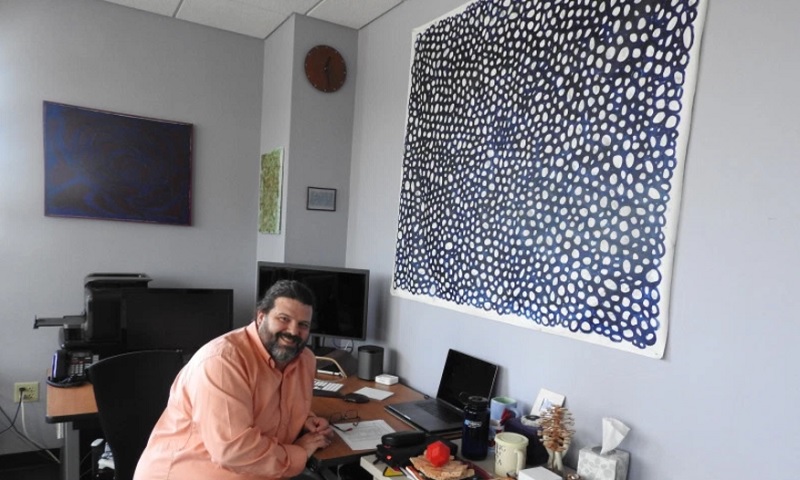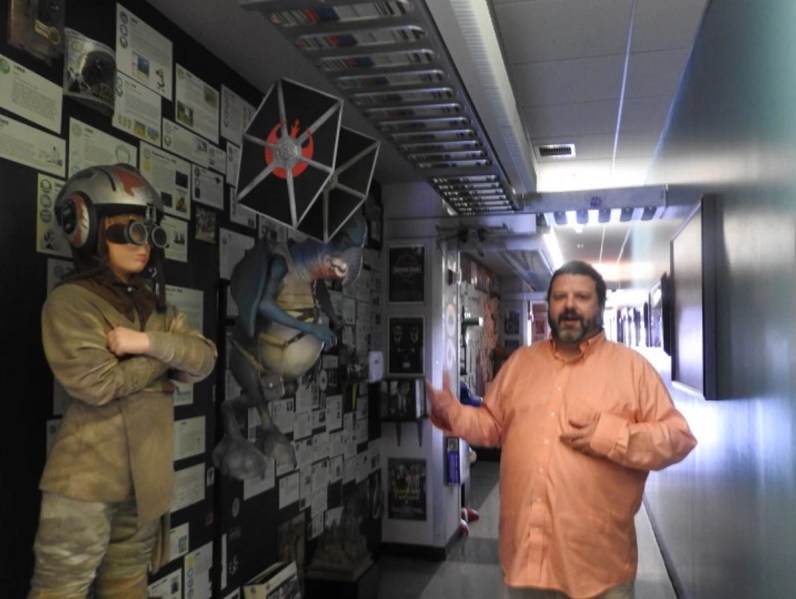testsetset
Carnegie Mellon University’s Entertainment Technology Center became famous in part because of The Last Lecture.
Computer scientist Randy Pausch and Donald Marinelli, a professor of drama, started the graduate school that combines entertainment, technology, and video games in 1999. Pausch contracted cancer, and he died in 2008. But before he did, the beloved teacher gave a final lecture about achieving your childhood dreams. It was so moving that it was turned into a book and chronicled by Diane Sawyer in an ABC Special. The YouTube video capturing Pausch’s inspirational message about life lessons has 18.6 million views.
Pausch’s memory is still very much alive at the ETC. The Last Lecture and the creativity it encouraged inspires Drew Davidson, the director of the ETC, which is now considered one of the best schools for video games, tech, and entertainment in the country. The place is a graduate school with about 160 students at any given time, and it sits in a building on the banks of Pittsburgh’s Monongahela river. In the middle of a 48-acre research park that was once a gigantic steel mill, the ETC is a source of Pittsburgh’s economic transformation.
It is where the old economy meets the new. You would never know that this was once the Rust Belt. And it shows that you can create game ecosystems pretty much anywhere in the world. The ETC has become a place where people build their dreams, and it’s a nice fit for our new VentureBeat channel Heartland Tech and our upcoming Blueprint conference in Reno, Nevada, on September 11-13.
I visited the place recently and talked with Davidson while my daughter and I toured the halls. I took pictures of the zany environment, which is festooned with Mario imagery in its bathrooms and has huge Batman figures in the halls. If you want to get inspired to be creative, this is the place to be.
“It’s like an MBA for people in the creative industries,” Davidson said. “It shows them creative career path opportunities. We joke that everybody here is like a mutt, trained in a lot of different things.”
Here’s an edited transcript of our interview.

Above: Drew Davidson is director of the Entertainment Technology Center at Carnegie Mellon University.
GamesBeat: Tell me about this place.
Drew Davidson: This is a great example of a past ETC project that’s grown. The ETC is very project-oriented. It’s going on 18-20 years old now. It was founded by Randy Pausch, out of computer science, and Don Marinelli, out of drama and the college of fine arts. Randy Pausch’s last lecture, I’m not sure if you’ve heard it, but if you haven’t you should watch it. It’s amazing.
Their idea at the time was inspired by Randy doing a sabbatical at Disney Imagineering. Imagineering was just throwing people from different disciplines together and making amazing things. He came back and pitched the idea – we should do a program like that. It’s a graduate program primarily, because that gives us people who have at least an undergraduate program. We do get people who have industry experience as well. We can pull in specifically from different disciplines.
We try to actively recruit about 40 percent from a technical background, whether they’re programmers or engineers, 40 percent from artistic backgrounds – 3D, 2D, visual effects — and then in the middle from all over. Creative writing, theater, drama, music, business. We’ve had biology majors. They all get thrown together and they’re going to do things together.
Don and Randy went around the country visiting places like Pixar and Electronic Arts and Universal and Disney looking for input. They wanted to craft a program that trains the next generation. The best way I can describe it, it’s like an MBA, but focused on the creative industries, as opposed to finance and business. You design and develop.
And so we take all these people together and they work on teams making things like this. It’s not just games. We’re interested in entertainment technology across the board. We have lots of video games, but also things like themed entertainment, location-based installations, mobile, virtual reality, augmented reality, short film and animation, you name it. The mix is really interesting to us.
That breadth is also where we’re curious in terms of fields. How do you use all of this, not just for entertainment, but also for education and learning, maybe medical and health? Pittsburgh has the University of Pittsburgh Medical Center, and we’ve done a lot of collaboration with them, how to use technology for health and medical. Business and training, of course. Civic engagement. Social impact issues. We’re very interested in exploring that range.
What’s fun for us and students—the universal is that you’re working with people, and people can suck. Your team can drive you crazy. The client can drive you crazy. Your boss can drive you crazy. If you do anything on the internet, look out. But that’s the universal. You’re always working with people and you have to figure that out. How do you collaborate and do creative problem-solving together in a conductive manner?
The thing that changes, which is exciting—five years from now, what’s going to happen? Ten years from now? Thirty years from now? They’re projecting that people her age are going to have 50- or 60-year careers, thanks to lifespan and cost of living. Five years ago, who would have guessed that VR was really coming back, and now it is. In 10 years, what’s next? Getting really comfortable doing something that’s never been done before, taking in lifelong learning and becoming comfortable with that, that’s something we try to focus on around here. Your kind of “I can figure it out” skills, as opposed to, “I just want to do the same job for 30 years.”
A group of students will be challenged by the ETC. Our projects can run in a variety of fashions. “Theme this hallway, so when you step off the elevator it doesn’t just feel empty.” When they originally started, both sides of the hallway were kind of like that. Then we did another semester where they had theming on both sides, but they had some fake panels. We do lots of tours here, particularly because of Randy’s Last Lecture. We get lots of kids in the building and they’ll touch anything. We thought we should put something up here to make it interactive. They started hanging screens and doing things with touch pads. It evolved into this behemoth. We’re only a two-year degree, so our students graduate and leave us, but the staff keeps this going.
GamesBeat: How many years has this robot thing been a work in progress?
Davidson: Six or seven? It stagnates sometimes. Students have to want to work on projects. We don’t force them to work on projects. This summer we’re working with some students and staff, our technical staff overseeing it, to think about ways to use all the screens. There are RFID readers here, things like that. When we originally did it there was no professional platform that could support six screens with six different inputs. We used Panda, an open source platform that we used to support with Disney. That allowed us to crack open the engine and make it work. When Unity came out Disney said, “Oh, we’ll put support in Panda [programming environment] and just use this Unity thing.” It took until just this year, believe it or not, but Unity can support this. We’re porting it to Unity.
GamesBeat: Jesse [Schell, CEO of Schell Games] talked about switching from Panda.
Davidson: Right. We’re sort of tech-agnostic. We want our students to understand how to problem-solve regardless of the tools. A big part of it is, we take that mix of students I was telling you about, and we put them through what we jokingly call boot camp. It’s a set of core classes they take together.
One is Building Virtual Worlds, that Randy Pausch taught. Now Jesse teaches it with Dave Culyba. It’s a rapid prototyping class. Team of five, two weeks, make something go. Shuffle, new teams, two weeks, go. Crazy crunchy timeline. There’s a lot of tech involved, but really, the meat of that class is problem-solving with people you don’t know well. You have to figure that out. Two weeks later, do it all over again. He talks about those head fakes. The head fake is, “Oh, it’s tech.” It’s not really tech. It’s people and problem-solving.

Above: Drew Davidson walks the halls of the Entertainment Technology Center.
At the same time they take a class called Visual Storytelling. That’s also a team-based class, kind of using the language of cinema. How do visuals and audio make something more immersive and engaging? But they’re in teams all semester long, working on three-week engagement making little short films to try to tell stories. We feel stories are an important part of any experience. There’s an intentional tension between those two classes. You’re switching all the time. And you know how group work is. “I love my team!” Nah, not so much. But you have to figure it out.
The other two classes—I teach a fun one. “This is a professional program. We want you to be able to talk about what you’re doing and why.” Understand design and development. Give them a sense of the creative industries and career path opportunities. Then the last class they take is everyone goes through improvisational acting. They have to take it together. It’s not about being funny or becoming better actors, but thinking about sharing – sharing credit, sharing ideas.
It’s a great brainstorming paradigm. Any time you think about interactive, we think performance is a better metaphor than cinema. Performance and theater is great way to think about it. It’s visceral. When things aren’t going well with improv on stage—we work really hard to have that translate into your creative brainstorming on a team. Are you doing that well together?
GamesBeat: How many people are here at any given time?
Davidson: We try to take about 80 students every year, and it’s a two-year program, so about 160. We do have a location out west, in Silicon Valley. We’re housed at Electronic Arts in Redwood Shores. The director out there is Carl Rosendahl. And I love this little cognitive dissonance: the other faculty member out there is Erin Hoffman. The EA_Spouse is now working for us at EA. They can take about 20 students a semester. It’s an opportunity, not an obligation. So we roughly have 140 students out here and 20 there, plus some co-ops and things like that.
Percentage-wise, we probably have 50 percent women to men. Because the breadth of our interest, it’s really attractive. It’s maybe 60 percent international now, with the bulk being from mainland China and Korea. About 60 percent come straight from undergrad.
GamesBeat: I thought it was interesting that Jesse was a stand-up comedian.
Davidson: Right. A street performer, a circus guy. Brenda, the faculty performer who teaches improv, was in an improv troupe that did it out in the streets. She did ren faires and stuff like that. There’s a weird—everyone here, we joke that we’re a mutt. Everyone brings a little bit of something.
GamesBeat: I found that the high-ranking schools in video games always have this mix of disciplines. USC has that collaboration between different departments.
Davidson: That’s what helps you excel. What made sense down here—after that first semester, they get through that and it prepares them for a semester on projects. They do stuff like this hallway, or they work with client-sponsored stuff, or grants, or research, or they can pitch their own ideas. We have a greenlight process, very similar to the industry.
Everyone here has worked in the industry. That’s a big feature of the program. We wanted that balance for a professional program. I worked in Austin back in the day, and now I consult a lot. It’s fun being at a school. You get a good sense of the pulse of what’s going on, because everyone talks to you. When I was in the industry, they wouldn’t even let me in the door. I was the competition.
GamesBeat: It seems like you guys encourage collaboration with industry. Jesse has this dual role.
Davidson: Right, exactly. Everybody is still actively involved. Jesse has his company. A lot of us consult. A lot of us are on boards or even more directly involved in some things. Everyone keeps a toe in the water. There’s a balance. Some of them are like, “Historically I’ve been in academics, but I’ve spun off companies.” Jesse has mostly been in the industry, but he teaches here. It’s a way to stay relevant, keep the street cred as it were.
Another thing that’s important to us—we hired Heather Kelley as one of our recent game designers. She had this mix. Jesse has a certain skill area. Chris Klug is another game designer here who comes from a focus on story. Heather is coming from art, aesthetics, indie, almost a punk sort of experience.
So the students come in and through two-three semesters they work on projects. They can do industry co-ops if they want. Then, on the back end, more than half go into games, because that’s where everyone is really passionate. We’re heavily recruited. I think 95 percent of our students get jobs within six months of graduating.
I remember one student who was an amazing 2D artist. He was getting offers to be a concept artist at companies, which is pretty rare. But his dad was like, “3D is better than 2D,” and he didn’t have a 3D portfolio at all. He could do gorgeous 3D art, but it took him a week, whereas someone with more of a proclivity would do it in a day. I said, “Come on, just start somewhere as a concept artist! That’s an amazing job!”

